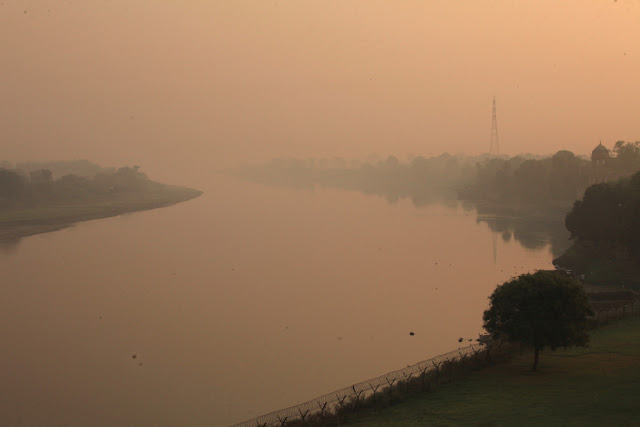The last time I visited the Taj Mahal, a pouring rain made the visit a sloppy mess and precluded any photography (although the huge crowds at that time were a really interesting part of the experience). This time, conditions could not have been more ideal and it was my first time in which I visited at sunrise - a huge difference with respect to the light and the lack of crowds. Agra does not have a commercial airport (we landed at a military airport) and many visitors make the 100 mile drive from Dehli and do not arrive until late morning. (During the peak tourist season, up to 45,000 people visit the Taj each day).The sunrise option was a great way to see this marvelous construction!
The Taj is merely the crown in a body of architectural jewels. Before seeing it, one must pass through a large gate that makes the building look more remote than it actually is. This is an actual design feature made purposely.
Once through the gate, its appearance changes as it is viewed along the long reflecting pools.
This is the view backwards to the entrance gate, composed a red sandstone blocks.
Sunrise east of the Taj Mahal on October 11, 2017.
Looking straight up along the front façade of the construction is beautiful Arabic calligraphy in black marble set within white marble. It mainly contains verses from the Koran. A short article on the calligraphy can be found here.
The façade has incredible inlaid stones that resemble flowers. The types of stones are varied from white and black marble, red jasper and coral, yellow onyx, blue lapis-lazuli, and others. It is incredibly well-rendered.

One of the minaret towers with the moon present above it. The Taj Mahal (literally, Crown of the Palace) is actually a mausoleum. It was commissioned by the Mughul emperor Shah Jahan in 1632 to house the tomb of his favorite wife. It was completed in 1653. Shah Jahan was imprisoned by his son (who assumed the throne) for "wasting" funds on its construction and his cell in the Agra Fort looked over the river toward his masterpiece. He looked at there Taj for the last five years of his life while in confinement.
The building is mostly made of Makrana marble, quarried in Rajasthan, India in the northwest part of the country. It is a Precambrian- age metamorphosed limestone that is part of the Dehli SuperGroup. Metamorphism commenced about 1,450 Ma during an event known as the Dehli Orogeny. This is very old marble. India holds a spectacular and robust geologic evolution!
A different view of the Taj from the west. The gardens surrounding the grounds (measuring nearly 1/3rd by 1/2 a kilometer) are impressive.
Western pathway among the gardens.
Red sandstone carving with inlaid stone border on one of the side buildings, themselves very impressive.
The Taj receives 8 million visitors per year and it is a kind of pilgrimage site for Indians.
Next posting from the Serengeti National Park in Tanzania.












Beautiful place,best pictures,Thanks for sharing.
ReplyDeleteExcellent post...
ReplyDelete